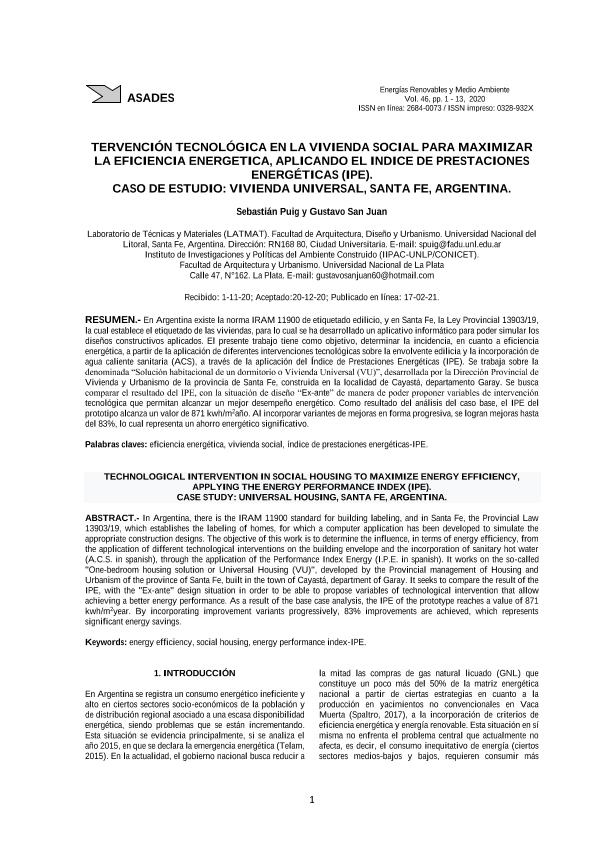Artículo
En Argentina existe la norma IRAM 11900 de etiquetado edilicio, y en Santa Fe, la Ley Provincial 13903/19, la cual establece el etiquetado de las viviendas, para lo cual se ha desarrollado un aplicativo informático para poder simular los diseños constructivos aplicados. El presente trabajo tiene como objetivo, determinar la incidencia, en cuanto a eficiencia energética, a partir de la aplicación de diferentes intervenciones tecnológicas sobre la envolvente edilicia y la incorporación de agua caliente sanitaria (ACS), a través de la aplicación del Índice de Prestaciones Energéticas (IPE). Se trabaja sobre la denominada “Solución habitacional de un dormitorio o Vivienda Universal (VU)”, desarrollada por la Dirección Provincial de Vivienda y Urbanismo de la provincia de Santa Fe, construida en la localidad de Cayastá, departamento Garay. Se busca comparar el resultado del IPE, con la situación de diseño “Ex-ante” de manera de poder proponer variables de intervención tecnológica que permitan alcanzar un mejor desempeño energético. Como resultado del análisis del caso base, el IPE del prototipo alcanza un valor de 871 kwh/m2 año. Al incorporar variantes de mejoras en forma progresiva, se logran mejoras hasta del 83%, lo cual representa un ahorro energético significativo. In Argentina, there is the IRAM 11900 standard for building labeling, and in Santa Fe, the Provincial Law 13903/19, which establishes the labeling of homes, for which a computer application has been developed to simulate the appropriate construction designs. The objective of this work is to determine the influence, in terms of energy efficiency, from the application of different technological interventions on the building envelope and the incorporation of sanitary hot water (A.C.S. in spanish), through the application of the Performance Index Energy (I.P.E. in spanish). It works on the so-called "One-bedroom housing solution or Universal Housing (VU)", developed by the Provincial management of Housing and Urbanism of the province of Santa Fe, built in the town of Cayastá, department of Garay. It seeks to compare the result of the IPE, with the "Ex-ante" design situation in order to be able to propose variables of technological intervention that allow achieving a better energy performance. As a result of the base case analysis, the IPE of the prototype reaches a value of 871 kwh/m2year. By incorporating improvement variants progressively, 83% improvements are achieved, which represents significant energy savings.
Intervención tecnológica en la vivienda social para maximizar la eficiencia energética, aplicando el índice de prestaciones energéticas (IPE). Caso de estudio: vivienda universal, Santa Fe, Argentina
Título:
Technological intervention in social housing to maximize energy efficiency, applying the energy performance index (IPE). Case Study: Universal Housing, Santa Fe, Argentina
Fecha de publicación:
05/2020
Editorial:
Asociación Argentina de Energías Renovables y Ambiente
Revista:
Energías Renovables y Medio Ambiente
ISSN:
0328-932X
e-ISSN:
2684-0073
Idioma:
Español
Tipo de recurso:
Artículo publicado
Clasificación temática:
Resumen
Archivos asociados
Licencia
Identificadores
Colecciones
Articulos (IIPAC)
Articulos de INSTITUTO DE INVESTIGACIONES Y POLITICAS DEL AMBIENTE CONSTRUIDO
Articulos de INSTITUTO DE INVESTIGACIONES Y POLITICAS DEL AMBIENTE CONSTRUIDO
Citación
Puig, Sebastián; San Juan, Gustavo Alberto; Intervención tecnológica en la vivienda social para maximizar la eficiencia energética, aplicando el índice de prestaciones energéticas (IPE). Caso de estudio: vivienda universal, Santa Fe, Argentina; Asociación Argentina de Energías Renovables y Ambiente; Energías Renovables y Medio Ambiente; 46; 5-2020; 1-13
Compartir




